
Maharashtra is a state in the western peninsular region of India occupying a substantial portion of the Deccan Plateau. It is bordered by the Arabian Sea to the west, the Indian states of Karnataka and Goa to the south, Telangana to the southeast and Chhattisgarh to the east, Gujarat and Madhya Pradesh to the north, and the Indian union territory of Dadra and Nagar Haveli and Daman and Diu to the northwest. Maharashtra is the second-most populous state in India.

Pune, previously spelled in English as Poona, is a city in Maharashtra state in the Deccan plateau in Western India. It is the administrative headquarters of the Pune district, and of Pune division. According to the 2011 Census of India, Pune is the ninth-most populous city in India with a population of 3.1 million residents within the city limits, and 7.2 million residents in the metropolitan region, making it the eight-most populous metropolitan area in India. The city of Pune is part of Pune Metropolitan Region. Pune is one of the largest IT hubs in India. It is also one of the most important automobile and manufacturing hubs of India. Pune is often referred to as "Oxford of the East" because of its highly regarded educational institutions. It has been ranked "the most liveable city in India" several times.

Kolhapur is a city on the banks of the Panchganga River in the southern part of the Indian state of Maharashtra.
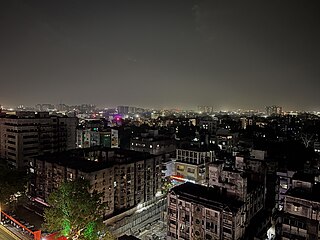
Nagpur is the third-largest city of the Indian state of Maharashtra after Mumbai and Pune. It is called the heart of India because of its central geographical location. It is the largest and most populated city in central India. Also known as the "Orange City", Nagpur is the 13th largest city in India by population. According to an Oxford's Economics report, Nagpur is projected to be the fifth fastest growing city in the world from 2019 to 2035 with an average growth of 8.41%. It has been proposed as one of the Smart Cities in Maharashtra and is one of the top ten cities in India in Smart City Project execution.
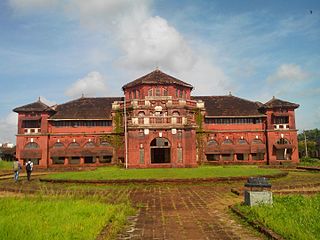
Ratnagiri is a port city on the Arabian Sea coast in Ratnagiri District in southwestern Maharashtra, India. The district is part of Konkan division of Maharashtra. The city is known for the Hapus or Alphonso mangoes. Ratnagiri is the birthplace of Indian independence activist Lokmanya Tilak. Thibaw, the last king of Burma, alongside his consort Supayalat and two infant daughters were exiled to a two-storied brick mansion in Ratnagiri. The building is now known as Thibaw Palace. This place has many villages like Karla, Rajiwada, Mirkarwada, etc.

Savitribai Phule Pune University (SPPU), formerly the University of Pune, is a public state university located in the city of Pune, India. It was established in 1949, and is spread over a 411 acres (1.66 km2) campus in the neighbourhood of Ganeshkhind. The university houses 46 academic departments. It has about 307 recognized research institutes and 612 affiliated colleges offering graduate and under-graduate courses. Savitribai Phule Pune University Ranked 12th NIRF Ranking in 2022

Pimpri-Chinchwad also known as "PCMC", is a city in the Indian state of Maharashtra. The city is about 15 km (9.3 mi) northwest of the historic city of Pune, at an altitude of 590 m (1,940 ft) above sea level. It is the fifth largest city in Maharashtra and the nineteenth largest city in India and the sixteenth largest satellite city in the world by population. The city is located 135 km (84 mi) southeast from the state's capital Mumbai. It is one of the most rapidly developing suburban areas in India and has emerged as the third fastest growing city in the country. It is well known for its automotive, IT and manufacturing industry.

Bhili, IPA:[bʱiːliː], is an indigenous language spoken in west-central India, in the states of Rajasthan, Gujarat, Maharashtra, and Madhya Pradesh. Other names for the language include Bhagoria and Bhilboli; several varieties are called Garasia. Bhili is a member of the Bhil languages, which are related to Gujarati and Rajasthani. The language is written using the Devanagari script.
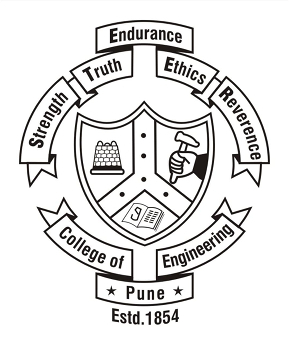
College Of Engineering Pune (COEP) Technological University is a unitary public university of the Government of Maharashtra, situated in Pune, Maharashtra, India. Established in 1854, it is the 3rd oldest engineering institute in India, after College of Engineering, Guindy (1794) and IIT Roorkee (1847). The students and alumni are colloquially referred to as COEPians. On 23 June 2022, Government of Maharashtra issued a notification regarding conversion of the college into an independent technological university. On 24 March 2022, both the houses of the state government passed the CoEP Technological University bill, which has conferred a unitary state university status on the institute.

Pune district is a district in Western Maharashtra with Administrative Headquarters in Pune city. Pune district is the most populous district in the Indian state of Maharashtra. It is one of the most industrialised districts in India.

Mohan Agashe is an Indian psychiatrist and actor. He was awarded the Sangeet Natak Akademi Award in 1996 in theatre.

Pune Airport is an international airport and an Indian Air Force base serving the city of Pune, Maharashtra, India. It is located at Lohegaon, approximately 11 km (6.8 mi) northeast of the historic centre of Pune. The airport is a civil enclave operated by the Airports Authority of India at the western side of Lohegaon Air Force Station of the Indian Air Force. The airport is the tenth-busiest airport by passenger traffic in India. The airport serves both domestic and international flights. In financial year 2023-24, the airport handled over 9.5 million passengers.

The Raja Dinkar Kelkar Museum is in Pune, Maharashtra, India. It contains the collection of Dr. Dinkar G. Kelkar (1896–1990), dedicated to the memory of his only son, Raja. The three-storey building houses various sculptures dating back to the 14th century. There are also ornaments made of ivory, silver and gold, musical instruments, war weapons and vessels.

The economy of the state of Maharashtra is the largest in India. Mumbai, the capital of Maharashtra and often described as the New York of India or Manhattan of India, is the financial capital and the most populous city of India with an estimated city proper population of 12.5 million (1.25 crore). The city is the entertainment, fashion, and commercial centre of India. Mumbai hosts the largest urban economy of any city in India. is considered the financial capital of India with the headquarters of almost all major banks, financial institutions, insurance companies and mutual funds being based in the city. India's largest stock exchange Bombay Stock Exchange, the oldest in Asia, is also located in the city. More than 41% of the S&P CNX 500 conglomerates have corporate offices in Maharashtra.
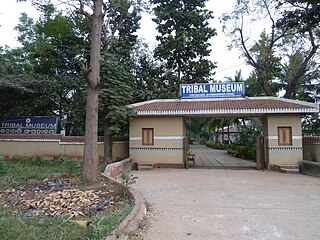
Tribal Research Institute Museum, Museum of Tribal Arts and Artifacts, is a museum in Bhubaneswar, Odisha inside the campus of Scheduled Castes & Scheduled Tribes Research & Training Institute. It is popularly known as Tribal Museum and conceptually labeled as Museum of Man. It has life-sized authentic tribal dwellings, created by the tribal craftsmen offers a view of the State's tribal heritage. It has sections which showcase tribal artifacts and objects, focusing on well researched, documented cultural life of tribals of Odisha. It is headed by a Director, who is in the rank of a University Professor, and the administrative control lies in the hands of ST, SC, Minorities, and Backward Classes Welfare Department, Government of Odisha.

The Katkari also called Kathodi, are an Indian tribe from Maharashtra. They have been categorised as a Scheduled tribe. They are bilingual, speaking the Katkari language, a dialect of the Marathi-Konkani languages, with each other; they speak Marathi with the Marathi speakers, who are a majority in the populace where they live. In Maharashtra the Katkari have been designated a Particularly vulnerable tribal group (PVTG), along with two other groups included in this sub-category: the Madia Gond and the Kolam. In the case of the Katkari this vulnerability derives from their history as a nomadic, forest-dwelling people listed by the British Raj under the Criminal Tribes Act of 1871, a stigma that continues to this day.

Nandkishore Kapote is Kathak Classical dancer, of Indian origin. He is a distinguished guide for a PhD programme in Tilak Tilak Maharashtra University and Sri Sri Centre for Kathak Research (SSCARK) at Sri Sri University.
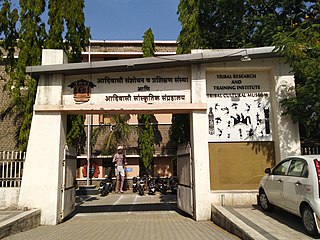
Tribal Research and Training Institute is a research and training institute based in Pune, India. It is dedicated to conduct research on tribal issues as also to evaluate the impact of various schemes on the tribes residing in Maharashtra. The institute came into existence in 1962.
National Digital Repository for Museums of India is a C-DAC-led project to create a seamless access to collections and artifacts organized according to themes, regardless of the physical and geographical locations of the museums that house them. The first public version developed on Dspace was released in 2002. The initial draft of Open Archival Information System (OAIS) was also released in year 2003. It is necessary to transform museums for greater relevance and application for the modern society. Therefore, while focusing the needs of Indian museums, Dr. Dinesh Katre, Senior Director at C-DAC initiated the development of e-curator software named as JATAN (जतन): Virtual Museum Builder in 2001, which was developed and released in 2004. Subsequently, JATAN (जतन) software was deployed in Chhatrapati Shivaji Maharaj Museum, Mumbai; Raja Dinkar Kelkar Museum, Pune and The Baroda Museum & Picture Gallery in Vadodara. Although the response from museums was lukewarm, C-DAC continued developing JATAN (जतन) software into a comprehensive digital collection management system for museums. As part of this research, early visions of using crowdsourcing method for metadata enrichment of museum artefacts and unified virtual catalogue for Indian museums was presented in 2005.

The Tribal Museum of Bhopal or Madhya Pradesh Tribal Museum is located close to the State Museum, Bhopal, near the Museum of Man/ Museum of Mankind in the Indian state of Madhya Pradesh. This is a museum dedicated to the living aspects of tribal life, indigenous knowledge systems, and aesthetics.





















